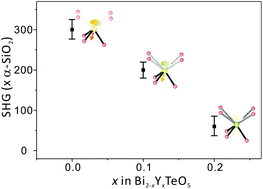Effect of polarizable lone pair cations on the second-harmonic generation (SHG) properties of noncentrosymmetric (NCS) Bi2−xYxTeO5 (x = 0–0.2)†
Abstract
Y3+-doped noncentrosymmetric (NCS) bismuth tellurite materials, Bi2−xYxTeO5 (x = 0, 0.1, and 0.2), have been synthesized through standard solid-state reactions and structurally characterized by powder neutron diffraction. The reported NCS materials crystallize in the orthorhombic space group Abm2 (no. 39), and exhibit pseudo-three-dimensional frameworks that are composed of BiO3, BiO5, and TeO3 polyhedra. Detailed diffraction studies show that the cell volume of Bi2−xYxTeO5 decreases with an increasing amount of Y3+on the Bi3+ sites. However, no ordering between Bi3+ and Y3+ was observed in the Bi2−xYxTeO5. Powder second-harmonic generation (SHG) measurements, using 1064 nm radiation, reveal that Bi2TeO5, Bi1.9Y0.1TeO5, and Bi1.8Y0.2TeO5 exhibit SHG efficiencies of approximately 300, 200, and 60 times that of α-SiO2, respectively. The reduction in SHG for Y3+-doped materials is consistent with the lack of net moment originating from polyhedra with a polarizable Bi3+ cation.


 Please wait while we load your content...
Please wait while we load your content...